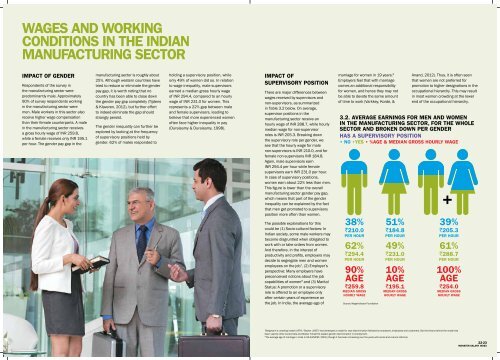Salary Index
1ojKTCu
1ojKTCu
Create successful ePaper yourself
Turn your PDF publications into a flip-book with our unique Google optimized e-Paper software.
WAGES AND WORKING<br />
CONDITIONS IN THE INDIAN<br />
MANUFACTURING SECTOR<br />
IMPACT OF GENDER<br />
Respondents of the survey in<br />
the manufacturing sector were<br />
predominantly male. Approximately<br />
90% of survey respondents working<br />
in the manufacturing sector were<br />
men. Male workers in this sector also<br />
receive higher wage compensation<br />
than their female counterparts. A male<br />
in the manufacturing sector receives<br />
a gross hourly wage of INR 259.8,<br />
while a female receives only INR 195.1<br />
per hour. The gender pay gap in the<br />
manufacturing sector is roughly about<br />
25%. Although western countries have<br />
tried to reduce or eliminate the gender<br />
pay gap, it is worth noting that no<br />
country has been able to close down<br />
the gender pay gap completely (Tijdens<br />
& Klaveren, 2012), but further effort<br />
to indeed eliminate the gap should<br />
strongly persist.<br />
The gender inequality can further be<br />
explored by looking at the frequency<br />
of supervisory positions held by<br />
gender. 62% of males responded to<br />
holding a supervisory position, while<br />
only 49% of women did so. In relation<br />
to wage inequality, male supervisors<br />
earned a median gross hourly wage<br />
of INR 294.4, compared to an hourly<br />
wage of INR 231.0 for women. This<br />
represents a 22% gap between male<br />
and female supervisors, leading to<br />
believe that more experienced women<br />
often face higher inequality in pay<br />
(Duraisamy & Duraisamy, 1998).<br />
IMPACT OF<br />
SUPERVISORY POSITION<br />
There are major differences between<br />
wages received by supervisors and<br />
non-supervisors, as summarized<br />
in Table 3.2 below. On average,<br />
supervisor positions in the<br />
manufacturing sector receive an<br />
hourly wage of INR 288.7, while hourly<br />
median wage for non-supervisor<br />
roles is INR 205.3. Breaking down<br />
the supervisory role per gender, we<br />
see that the hourly wage for male<br />
non-supervisors is INR 210.0, and for<br />
female non-supervisors INR 184.8.<br />
Again, male supervisors earn<br />
INR 294.4 per hour while female<br />
supervisors earn INR 231.0 per hour.<br />
In case of supervisory positions,<br />
women earn about 22% less than men.<br />
This figure is lower than the overall<br />
manufacturing sector gender pay gap,<br />
which means that part of the gender<br />
inequality can be explained by the fact<br />
that men get promoted to supervisory<br />
position more often than women.<br />
The possible explanations for this<br />
could be (1) Socio-cultural factors: In<br />
Indian society, some male workers may<br />
become disgruntled when obligated to<br />
work with or take orders from women.<br />
And therefore, in the interest of<br />
productivity and profits, employers may<br />
decide to segregate men and women<br />
employees on the job 7 , (2) Employer’s<br />
perspective: Many employers have<br />
preconceived notions about the job<br />
capabilities of women 8 and (3) Marital<br />
Status: A promotion or a supervisory<br />
role is offered to an employee only<br />
after certain years of experience on<br />
the job. In India, the average age of<br />
marriage for women in 19 years. 9<br />
Employers feel that with marriage<br />
comes an additional responsibility<br />
for women, and hence they may not<br />
be able to devote the same amount<br />
of time to work (Varkkey, Korde, &<br />
Anand, 2012). Thus, it is often seen<br />
that women are not preferred for<br />
promotion to higher designations in the<br />
occupational hierarchy. This may result<br />
in most women crowding at the lower<br />
end of the occupational hierarchy.<br />
3.2. AVERAGE EARNINGS FOR MEN AND WOMEN<br />
IN THE MANUFACTURING SECTOR, FOR THE WHOLE<br />
SECTOR AND BROKEN DOWN PER GENDER<br />
HAS A SUPERVISORY POSITION<br />
• NO •YES • %AGE & MEDIAN GROSS HOURLY WAGE<br />
38%<br />
`210.0<br />
PER HOUR<br />
62%<br />
`294.4<br />
PER HOUR<br />
90%<br />
AGE<br />
`259.8<br />
MEDIAN GROSS<br />
HOURLY WAGE<br />
Source: WageIndicator Foundation<br />
51%<br />
`184.8<br />
PER HOUR<br />
49%<br />
`231.0<br />
PER HOUR<br />
10%<br />
AGE<br />
`195.1<br />
MEDIAN GROSS<br />
HOURLY WAGE<br />
39%<br />
`205.3<br />
PER HOUR<br />
61%<br />
`288.7<br />
PER HOUR<br />
100%<br />
AGE<br />
`254.0<br />
MEDIAN GROSS<br />
HOURLY WAGE<br />
7<br />
Bergmann’s crowding model (1974). 8 Becker (1957) had developed a model for race discrimination followed by employers, employees and customers. But the theory behind the model has<br />
been used by other economists and Becker himself to explain gender discrimination in employment.<br />
9<br />
The average age of marriage in India is 18.3(UNICEF, 2001) (though it has been increasing over the years with social and cultural reforms).<br />
22-23<br />
MONSTER SALARY INDEX


